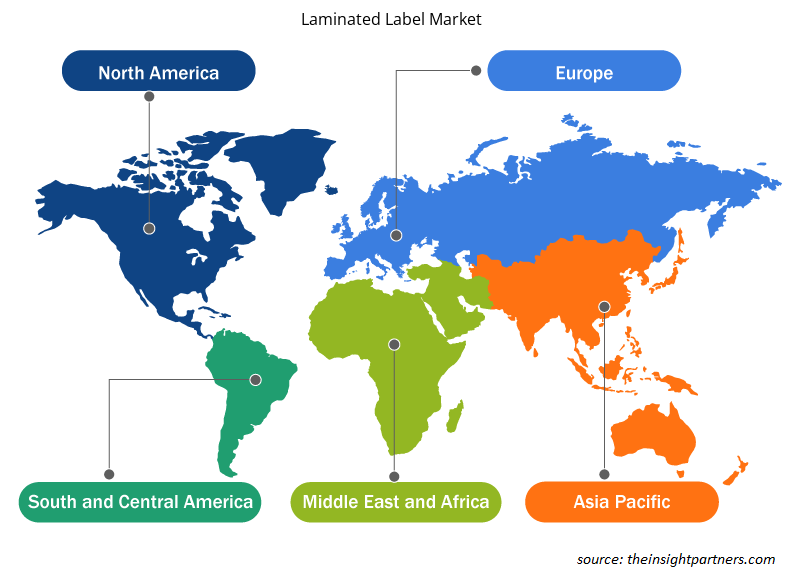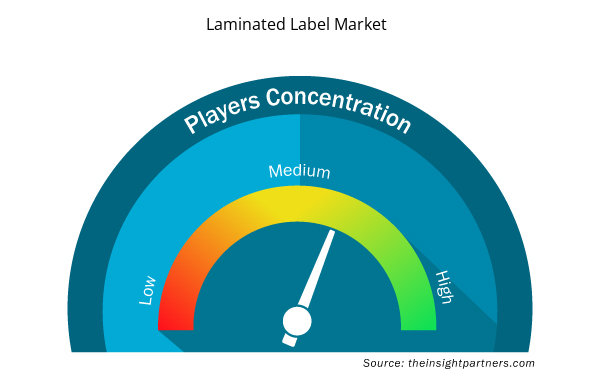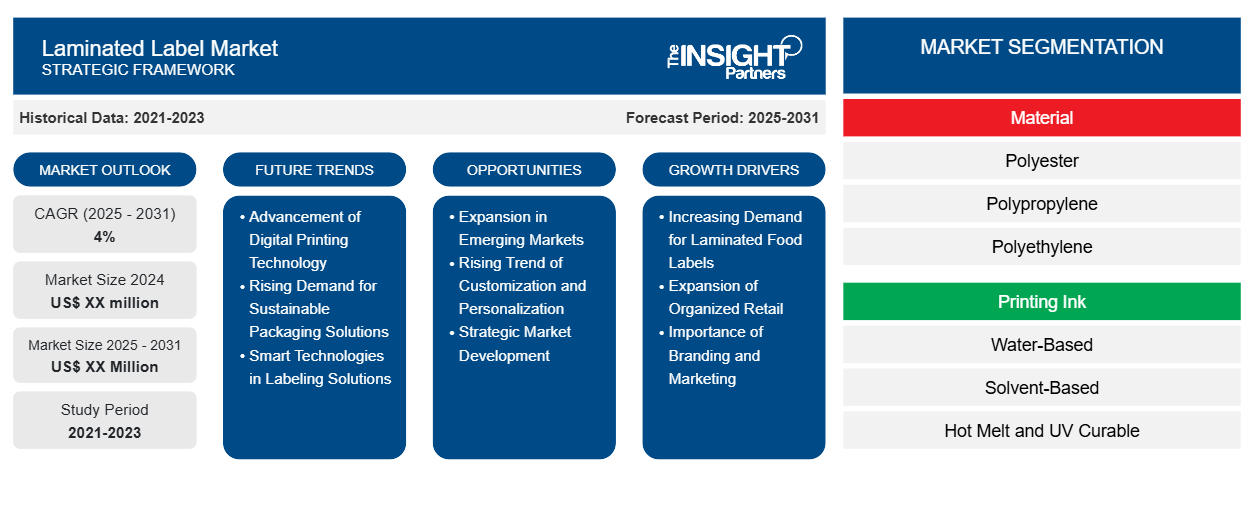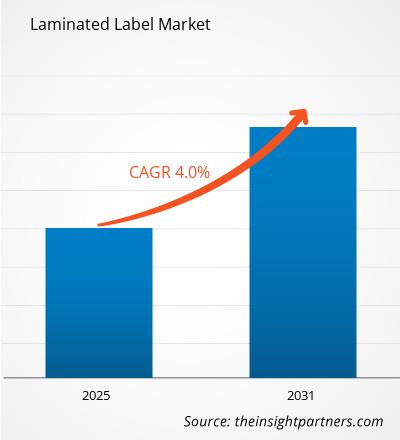Se espera que el mercado de etiquetas laminadas registre una CAGR del 4% entre 2023 y 2031, con un tamaño de mercado que se expandirá de US$ XX millones en 2023 a US$ XX millones en 2031.
El informe está segmentado por material (poliéster, polipropileno, polietileno, vinilo y otros) y tinta de impresión (a base de agua, a base de solvente, termofusible y curable por UV). El informe presenta además un análisis basado en la industria de uso final (alimentos y bebidas, bienes de consumo, electrónica, cuidado personal y cosméticos, productos farmacéuticos y otros). El análisis global se desglosa aún más a nivel regional y por países principales. El tamaño del mercado y el pronóstico a nivel global, regional y de país para todos los segmentos clave del mercado están cubiertos bajo el alcance. El informe ofrece el valor en USD para el análisis y los segmentos anteriores. El informe proporciona estadísticas clave sobre el estado del mercado de los actores clave del mercado y ofrece tendencias y oportunidades del mercado.
Propósito del Informe
El informe Laminated Label Market de The Insight Partners tiene como objetivo describir el panorama actual y el crecimiento futuro, los principales factores impulsores, los desafíos y las oportunidades. Esto proporcionará información a diversas partes interesadas del negocio, como:
- Proveedores/fabricantes de tecnología: Para comprender la dinámica cambiante del mercado y conocer las oportunidades potenciales de crecimiento, lo que les permitirá tomar decisiones estratégicas informadas.
- Inversionistas: Realizar un análisis exhaustivo de tendencias sobre la tasa de crecimiento del mercado, las proyecciones financieras del mercado y las oportunidades que existen en toda la cadena de valor.
- Órganos reguladores: Regular las políticas y vigilar las actividades del mercado con el objetivo de minimizar los abusos, preservar la confianza de los inversores y defender la integridad y estabilidad del mercado.
Segmentación del mercado de etiquetas laminadas
Material
- Poliéster
- Polipropileno
- Polietileno
- Vinilo y otros
Tinta de impresión
- A base de agua
- A base de disolventes
- Adhesivo termofusible y curable por UV
Industria de uso final
- Alimentos y bebidas
- Bienes de consumo
- Electrónica
- Cuidado Personal y Cosmética
- Productos farmacéuticos y otros
Geografía
- América del norte
- Europa
- Asia-Pacífico
- América del Sur y Central
- Oriente Medio y África
Geografía
- América del norte
- Europa
- Asia-Pacífico
- América del Sur y Central
- Oriente Medio y África
Personalice este informe según sus necesidades
Obtendrá personalización en cualquier informe, sin cargo, incluidas partes de este informe o análisis a nivel de país, paquete de datos de Excel, así como también grandes ofertas y descuentos para empresas emergentes y universidades.
- Obtenga las principales tendencias clave del mercado de este informe.Esta muestra GRATUITA incluirá análisis de datos, desde tendencias del mercado hasta estimaciones y pronósticos.
Factores impulsores del crecimiento del mercado de etiquetas laminadas
- Demanda creciente de etiquetas laminadas para alimentos: el sector de alimentos y bebidas es especialmente aficionado a las etiquetas laminadas. Dadas las detalladas normas y regulaciones relativas al etiquetado de alimentos, estos fabricantes han estado buscando etiquetas de alta calidad y duraderas que puedan soportar incluso las peores condiciones de agua, calor y fricción. Debido a las propiedades resistentes a la abrasión de las etiquetas laminadas, se garantiza que los detalles esenciales sobre los productos se mantendrán en buenas condiciones hasta que se agoten. Con un número cada vez mayor de consumidores que se inclinan por los alimentos ya envasados y procesados, la predicción es que el mercado de las etiquetas laminadas crecerá increíblemente rápido.
- Expansión del comercio minorista organizado: la expansión del comercio minorista y el comercio electrónico ha presionado aún más las oportunidades del mercado de etiquetas laminadas. El cambio hacia las compras en línea ha aumentado la demanda de etiquetado, en particular en lo que respecta a la marca y la identificación de los productos cuando las mercancías están en tránsito. El alcance de las etiquetas laminadas no se limita a su uso funcional, sino que también se extiende a las actividades de promoción empresarial. El alivio de las restricciones a la publicidad y la necesidad de etiquetas con imágenes llamativas y a prueba de manipulaciones en los productos vendidos directamente al consumidor a través de Internet está impulsando las actividades en muchos segmentos del comercio minorista.
- Importancia de la marca y el marketing: La marca y el marketing se han convertido en uno de los factores más importantes que motivan a los consumidores a comprar un artículo en el mercado actual. Debido a esto, las corporaciones han comenzado a producir etiquetas mejores y más atractivas para sus productos, buscando superar a sus rivales. Las etiquetas laminadas tienen un aspecto exquisito y pueden venir en diferentes colores, estructuras y acabados que pueden darle vida al empaque en general. Esto es más pronunciado en las industrias de cosméticos y productos de cuidado personal y del hogar y la necesidad de soluciones de etiquetado laminado.
Tendencias futuras del mercado de etiquetas laminadas
- Avance de la tecnología de impresión digital: La transformación de la industria de las etiquetas laminadas se ha visto significativamente afectada debido al avance de la tecnología de impresión digital. Facilita la producción de incluso la colección más pequeña de señalización que contiene imágenes y colores brillantes a un ritmo rápido. La impresión digital abre la puerta a la personalización eficiente de etiquetas por parte de los fabricantes para sus clientes que responden a etiquetas de cualquier tipo. La posibilidad de ofrecer productos con etiquetas personalizadas con poco o ningún costo de instalación está revolucionando este mercado, haciéndolo amigable para las pequeñas empresas y las empresas emergentes.
- Demanda creciente de soluciones de embalaje sostenibles: a medida que el calentamiento global se vuelve una cuestión cada vez más importante, el mercado de etiquetas laminadas más ortodoxo también tiende a producir una nueva generación de etiquetas laminadas ecológicas. Cada vez más productores abordan la cuestión de los materiales reciclables avanzados, por ejemplo, películas degradables y pegamentos biodegradables, para fabricar etiquetas menos dañinas para la naturaleza. Abordar estos aspectos no solo satisface las necesidades de los clientes que buscan productos más respetuosos con el medio ambiente, sino que también responde a la creciente demanda de las autoridades en materia de sostenibilidad. Esto, a su vez, aumenta la preocupación y el enfoque en agregar características sostenibles a las soluciones de etiquetado, lo que aumenta la competencia en el mercado de soluciones de etiquetado laminado.
- Tecnologías inteligentes en soluciones de etiquetado: una tendencia emergente en el mercado de las etiquetas laminadas es la superposición de tecnologías inteligentes en las soluciones de etiquetado. La implementación de dichos sistemas puede cubrir el paquete con etiquetas inteligentes que contienen códigos QR, etiquetas NFC o chips RFID, lo que permite a la marca brindar información sobre el producto e incluso interactuar con el consumidor. Esto proporciona un valor agregado al uso de etiquetas laminadas, ya que permiten a las empresas administrar los artículos en stock, mantener registros de productos y recopilar detalles de los clientes. Con la creciente penetración de la tecnología inteligente, también aumentará la oportunidad de acceder a las etiquetas laminadas para obtener más información.
Oportunidades de mercado para etiquetas laminadas
- Expansión en mercados emergentes: Es un buen momento para que los fabricantes de etiquetas laminadas se adentren en nuevos territorios, especialmente en Asia-Pacífico, América Latina y África. Existe un aumento en la demanda de productos envasados y sistemas de etiquetado efectivos en estas áreas debido a su rápida urbanización y a la mejora de la situación económica de la población y de la emergente clase media. Se puede ingresar con éxito a los mercados locales mediante la localización adecuada de los productos y la colaboración con los distribuidores locales.
- Tendencia creciente de personalización y personalización: el mercado de etiquetas laminadas se beneficiará significativamente del cambio en curso en los gustos y preferencias hacia la personalización y personalización masiva de productos. En la actualidad, se puede observar con mayor frecuencia que las marcas desean soluciones de etiquetado únicas que se distingan de cualquier otra y conecten con los consumidores de manera notable. Este es un factor importante para los fabricantes, ya que pueden brindar opciones de personalización, como impresión de datos variables, diferentes formas y texturas. Esto ayudará a generar lealtad a la marca en el mercado de consumo y ayudará en la gestión de la misma.
- Desarrollo Estratégico de Mercado: Existen muchas posibilidades para que los fabricantes de etiquetas laminadas expandan su negocio, por ejemplo, a través de fusiones y adquisiciones o alianzas estratégicas con empresas involucradas en el sector de embalaje, logística o venta minorista. Por ejemplo, unir fuerzas con una empresa de embalaje o de comercio electrónico puede permitir a las empresas ofrecer algunos servicios de embalaje donde las etiquetas laminadas se incluirán en la cadena de suministro de embalaje. Con una orientación a este grupo en particular, las empresas pueden ganar más visibilidad en el mercado local y promover productos adecuados de acuerdo con las tendencias, la evolución y las necesidades del mercado.
Perspectivas regionales del mercado de etiquetas laminadas
Los analistas de Insight Partners explicaron en detalle las tendencias y los factores regionales que influyen en el mercado de etiquetas laminadas durante el período de pronóstico. Esta sección también analiza los segmentos y la geografía del mercado de etiquetas laminadas en América del Norte, Europa, Asia Pacífico, Oriente Medio y África, y América del Sur y Central.

- Obtenga datos regionales específicos para el mercado de etiquetas laminadas
Alcance del informe de mercado de etiquetas laminadas
| Atributo del informe | Detalles |
|---|---|
| Tamaño del mercado en 2023 | XX millones de dólares estadounidenses |
| Tamaño del mercado en 2031 | US$ XX millones |
| CAGR global (2023 - 2031) | 4% |
| Datos históricos | 2021-2022 |
| Período de pronóstico | 2024-2031 |
| Segmentos cubiertos | Por material
|
| Regiones y países cubiertos | América del norte
|
| Líderes del mercado y perfiles de empresas clave |
|
Densidad de actores del mercado de etiquetas laminadas: comprensión de su impacto en la dinámica empresarial
El mercado de etiquetas laminadas está creciendo rápidamente, impulsado por la creciente demanda de los usuarios finales debido a factores como la evolución de las preferencias de los consumidores, los avances tecnológicos y una mayor conciencia de los beneficios del producto. A medida que aumenta la demanda, las empresas amplían sus ofertas, innovan para satisfacer las necesidades de los consumidores y aprovechan las tendencias emergentes, lo que impulsa aún más el crecimiento del mercado.
La densidad de actores del mercado se refiere a la distribución de las empresas o firmas que operan dentro de un mercado o industria en particular. Indica cuántos competidores (actores del mercado) están presentes en un espacio de mercado determinado en relación con su tamaño o valor total de mercado.
Las principales empresas que operan en el mercado de etiquetas laminadas son:
- Compañía 3M
- Corporación Avery Dennison
- Compañía Bemis, Inc.
- CCL Industries Inc. 5. Grupo Constantia Flexibles GmbH
- Coveris Holdings SA
Descargo de responsabilidad : Las empresas enumeradas anteriormente no están clasificadas en ningún orden particular.

- Obtenga una descripción general de los principales actores clave del mercado de etiquetas laminadas
Puntos de venta clave
- Cobertura integral: el informe cubre de manera integral el análisis de productos, servicios, tipos y usuarios finales del mercado de etiquetas laminadas, proporcionando un panorama holístico.
- Análisis de expertos: el informe se compila sobre la base de un profundo conocimiento de expertos y analistas de la industria.
- Información actualizada: El informe asegura relevancia comercial debido a su cobertura de información reciente y tendencias de datos.
- Opciones de personalización: este informe se puede personalizar para satisfacer los requisitos específicos del cliente y adaptarse adecuadamente a las estrategias comerciales.
Por lo tanto, el informe de investigación sobre el mercado de etiquetas laminadas puede ayudar a abrir el camino para descifrar y comprender el escenario de la industria y las perspectivas de crecimiento. Si bien puede haber algunas preocupaciones válidas, los beneficios generales de este informe tienden a superar las desventajas.
- Análisis histórico (2 años), año base, pronóstico (7 años) con CAGR
- Análisis PEST y FODA
- Tamaño del mercado Valor/volumen: global, regional, nacional
- Industria y panorama competitivo
- Conjunto de datos de Excel



Report Coverage
Revenue forecast, Company Analysis, Industry landscape, Growth factors, and Trends

Segment Covered
This text is related
to segments covered.

Regional Scope
North America, Europe, Asia Pacific, Middle East & Africa, South & Central America

Country Scope
This text is related
to country scope.
Preguntas frecuentes
Based on geography, Asia Pacific held the significant share of the laminated label market due to growth in the end-use industries
Advancement in digital printing technology is expected to be the key market trends
Based on end-use industry, consumer goods segment is expected to witness the fastest growth during the forecast period
Growth in the e-commerce and retail sector is driving the market growth
3M; Avery Dennison Corporation; CCL Industries; Lecta Adestor; Flexcon Company, Inc are some of the key players operating in the laminated label market
The Laminated Label Market is estimated to witness a CAGR of 4% from 2023 to 2031
Trends and growth analysis reports related to Chemicals and Materials : READ MORE..
1. 3M Company
2. Avery Dennison Corporation
3. Bemis Company, Inc.
4. CCL Industries Inc.
5 . Constantia Flexibles Group GmbH
6. Coveris Holdings S.A.
7. Flexcon Company, Inc.
8. R.R. Donnelley and Sons Company
9. Stickythings Limited
10. Torraspapel Adestor
The Insight Partners performs research in 4 major stages: Data Collection & Secondary Research, Primary Research, Data Analysis and Data Triangulation & Final Review.
- Data Collection and Secondary Research:
As a market research and consulting firm operating from a decade, we have published and advised several client across the globe. First step for any study will start with an assessment of currently available data and insights from existing reports. Further, historical and current market information is collected from Investor Presentations, Annual Reports, SEC Filings, etc., and other information related to company’s performance and market positioning are gathered from Paid Databases (Factiva, Hoovers, and Reuters) and various other publications available in public domain.
Several associations trade associates, technical forums, institutes, societies and organization are accessed to gain technical as well as market related insights through their publications such as research papers, blogs and press releases related to the studies are referred to get cues about the market. Further, white papers, journals, magazines, and other news articles published in last 3 years are scrutinized and analyzed to understand the current market trends.
- Primary Research:
The primarily interview analysis comprise of data obtained from industry participants interview and answers to survey questions gathered by in-house primary team.
For primary research, interviews are conducted with industry experts/CEOs/Marketing Managers/VPs/Subject Matter Experts from both demand and supply side to get a 360-degree view of the market. The primary team conducts several interviews based on the complexity of the markets to understand the various market trends and dynamics which makes research more credible and precise.
A typical research interview fulfils the following functions:
- Provides first-hand information on the market size, market trends, growth trends, competitive landscape, and outlook
- Validates and strengthens in-house secondary research findings
- Develops the analysis team’s expertise and market understanding
Primary research involves email interactions and telephone interviews for each market, category, segment, and sub-segment across geographies. The participants who typically take part in such a process include, but are not limited to:
- Industry participants: VPs, business development managers, market intelligence managers and national sales managers
- Outside experts: Valuation experts, research analysts and key opinion leaders specializing in the electronics and semiconductor industry.
Below is the breakup of our primary respondents by company, designation, and region:

Once we receive the confirmation from primary research sources or primary respondents, we finalize the base year market estimation and forecast the data as per the macroeconomic and microeconomic factors assessed during data collection.
- Data Analysis:
Once data is validated through both secondary as well as primary respondents, we finalize the market estimations by hypothesis formulation and factor analysis at regional and country level.
- Macro-Economic Factor Analysis:
We analyse macroeconomic indicators such the gross domestic product (GDP), increase in the demand for goods and services across industries, technological advancement, regional economic growth, governmental policies, the influence of COVID-19, PEST analysis, and other aspects. This analysis aids in setting benchmarks for various nations/regions and approximating market splits. Additionally, the general trend of the aforementioned components aid in determining the market's development possibilities.
- Country Level Data:
Various factors that are especially aligned to the country are taken into account to determine the market size for a certain area and country, including the presence of vendors, such as headquarters and offices, the country's GDP, demand patterns, and industry growth. To comprehend the market dynamics for the nation, a number of growth variables, inhibitors, application areas, and current market trends are researched. The aforementioned elements aid in determining the country's overall market's growth potential.
- Company Profile:
The “Table of Contents” is formulated by listing and analyzing more than 25 - 30 companies operating in the market ecosystem across geographies. However, we profile only 10 companies as a standard practice in our syndicate reports. These 10 companies comprise leading, emerging, and regional players. Nonetheless, our analysis is not restricted to the 10 listed companies, we also analyze other companies present in the market to develop a holistic view and understand the prevailing trends. The “Company Profiles” section in the report covers key facts, business description, products & services, financial information, SWOT analysis, and key developments. The financial information presented is extracted from the annual reports and official documents of the publicly listed companies. Upon collecting the information for the sections of respective companies, we verify them via various primary sources and then compile the data in respective company profiles. The company level information helps us in deriving the base number as well as in forecasting the market size.
- Developing Base Number:
Aggregation of sales statistics (2020-2022) and macro-economic factor, and other secondary and primary research insights are utilized to arrive at base number and related market shares for 2022. The data gaps are identified in this step and relevant market data is analyzed, collected from paid primary interviews or databases. On finalizing the base year market size, forecasts are developed on the basis of macro-economic, industry and market growth factors and company level analysis.
- Data Triangulation and Final Review:
The market findings and base year market size calculations are validated from supply as well as demand side. Demand side validations are based on macro-economic factor analysis and benchmarks for respective regions and countries. In case of supply side validations, revenues of major companies are estimated (in case not available) based on industry benchmark, approximate number of employees, product portfolio, and primary interviews revenues are gathered. Further revenue from target product/service segment is assessed to avoid overshooting of market statistics. In case of heavy deviations between supply and demand side values, all thes steps are repeated to achieve synchronization.
We follow an iterative model, wherein we share our research findings with Subject Matter Experts (SME’s) and Key Opinion Leaders (KOLs) until consensus view of the market is not formulated – this model negates any drastic deviation in the opinions of experts. Only validated and universally acceptable research findings are quoted in our reports.
We have important check points that we use to validate our research findings – which we call – data triangulation, where we validate the information, we generate from secondary sources with primary interviews and then we re-validate with our internal data bases and Subject matter experts. This comprehensive model enables us to deliver high quality, reliable data in shortest possible time.


 Obtenga una muestra gratuita de este informe
Obtenga una muestra gratuita de este informe